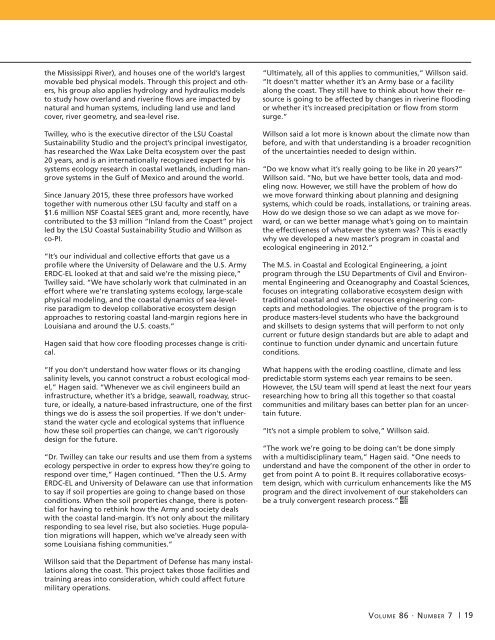CEAC-2021-07-July
You also want an ePaper? Increase the reach of your titles
YUMPU automatically turns print PDFs into web optimized ePapers that Google loves.
the Mississippi River), and houses one of the world’s largest<br />
movable bed physical models. Through this project and others,<br />
his group also applies hydrology and hydraulics models<br />
to study how overland and riverine flows are impacted by<br />
natural and human systems, including land use and land<br />
cover, river geometry, and sea-level rise.<br />
Twilley, who is the executive director of the LSU Coastal<br />
Sustainability Studio and the project’s principal investigator,<br />
has researched the Wax Lake Delta ecosystem over the past<br />
20 years, and is an internationally recognized expert for his<br />
systems ecology research in coastal wetlands, including mangrove<br />
systems in the Gulf of Mexico and around the world.<br />
Since January 2015, these three professors have worked<br />
together with numerous other LSU faculty and staff on a<br />
$1.6 million NSF Coastal SEES grant and, more recently, have<br />
contributed to the $3 million “Inland from the Coast” project<br />
led by the LSU Coastal Sustainability Studio and Willson as<br />
co-PI.<br />
“It’s our individual and collective efforts that gave us a<br />
profile where the University of Delaware and the U.S. Army<br />
ERDC-EL looked at that and said we’re the missing piece,”<br />
Twilley said. “We have scholarly work that culminated in an<br />
effort where we’re translating systems ecology, large-scale<br />
physical modeling, and the coastal dynamics of sea-levelrise<br />
paradigm to develop collaborative ecosystem design<br />
approaches to restoring coastal land-margin regions here in<br />
Louisiana and around the U.S. coasts.”<br />
Hagen said that how core flooding processes change is critical.<br />
“If you don’t understand how water flows or its changing<br />
salinity levels, you cannot construct a robust ecological model,”<br />
Hagen said. “Whenever we as civil engineers build an<br />
infrastructure, whether it’s a bridge, seawall, roadway, structure,<br />
or ideally, a nature-based infrastructure, one of the first<br />
things we do is assess the soil properties. If we don’t understand<br />
the water cycle and ecological systems that influence<br />
how these soil properties can change, we can’t rigorously<br />
design for the future.<br />
“Dr. Twilley can take our results and use them from a systems<br />
ecology perspective in order to express how they’re going to<br />
respond over time,” Hagen continued. “Then the U.S. Army<br />
ERDC-EL and University of Delaware can use that information<br />
to say if soil properties are going to change based on those<br />
conditions. When the soil properties change, there is potential<br />
for having to rethink how the Army and society deals<br />
with the coastal land-margin. It’s not only about the military<br />
responding to sea level rise, but also societies. Huge population<br />
migrations will happen, which we’ve already seen with<br />
some Louisiana fishing communities.”<br />
“Ultimately, all of this applies to communities,” Willson said.<br />
“It doesn’t matter whether it’s an Army base or a facility<br />
along the coast. They still have to think about how their resource<br />
is going to be affected by changes in riverine flooding<br />
or whether it’s increased precipitation or flow from storm<br />
surge.”<br />
Willson said a lot more is known about the climate now than<br />
before, and with that understanding is a broader recognition<br />
of the uncertainties needed to design within.<br />
“Do we know what it’s really going to be like in 20 years?”<br />
Willson said. “No, but we have better tools, data and modeling<br />
now. However, we still have the problem of how do<br />
we move forward thinking about planning and designing<br />
systems, which could be roads, installations, or training areas.<br />
How do we design those so we can adapt as we move forward,<br />
or can we better manage what’s going on to maintain<br />
the effectiveness of whatever the system was? This is exactly<br />
why we developed a new master’s program in coastal and<br />
ecological engineering in 2012.”<br />
The M.S. in Coastal and Ecological Engineering, a joint<br />
program through the LSU Departments of Civil and Environmental<br />
Engineering and Oceanography and Coastal Sciences,<br />
focuses on integrating collaborative ecosystem design with<br />
traditional coastal and water resources engineering concepts<br />
and methodologies. The objective of the program is to<br />
produce masters-level students who have the background<br />
and skillsets to design systems that will perform to not only<br />
current or future design standards but are able to adapt and<br />
continue to function under dynamic and uncertain future<br />
conditions.<br />
What happens with the eroding coastline, climate and less<br />
predictable storm systems each year remains to be seen.<br />
However, the LSU team will spend at least the next four years<br />
researching how to bring all this together so that coastal<br />
communities and military bases can better plan for an uncertain<br />
future.<br />
“It’s not a simple problem to solve,” Willson said.<br />
“The work we’re going to be doing can’t be done simply<br />
with a multidisciplinary team,” Hagen said. “One needs to<br />
understand and have the component of the other in order to<br />
get from point A to point B. It requires collaborative ecosystem<br />
design, which with curriculum enhancements like the MS<br />
program and the direct involvement of our stakeholders can<br />
be a truly convergent research process.”<br />
Willson said that the Department of Defense has many installations<br />
along the coast. This project takes those facilities and<br />
training areas into consideration, which could affect future<br />
military operations.<br />
Volume 86 · Number 7 | 19


















